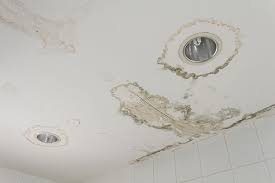
Experiencing water damage to your ceilings can feel like a setback. It's a situation no homeowner wants to contend with. Yet, timely action can mitigate the damages and save you from costly repairs.
This handy guide presents steps detailing what you can do when your ceiling has suffered water damage, starting from spotting the initial signs to navigating insurance claims. We'll also shed some light on how professional water damage companies could be your best bet in resolving the issue efficiently and effectively.
Let me guide you on this journey to reclaiming your safe and dry living space.
1. Identifying Water Damage on Your Ceilings
The sooner you notice potential water damage, the quicker and more efficient the treatment process can be. Therefore, a proactive approach is your best friend. Keep a keen eye on signs like stains on your ceilings or walls, especially after a heavy rainstorm or any leakages in your home.
Yellowish stains and peeling paint are some other glaring indicators of water damage that should not be ignored. Such irregularities often suggest trapped moisture, possibly from a slow but steady leak.
By taking note of these signs early on, you might even save yourself from more costly repairs down the line. Also, remember to engage your sense of smell as well - an unusual musty odor could indicate mold or mildew growth in hidden places due to prolonged dampness.
2. Immediate Actions to Prevent Further Damage
As soon as you identify water damage, it’s crucial to act promptly to prevent further havoc. Here’s a roadmap of what to do:
- Unplug all electrical appliances in the room: Safety is paramount. Start by unplugging all electric appliances in and around the damaged area.
- Remove furniture and other valuables: Protect your belongings from water damage by moving them away from the affected area.
- Contain the water leakage if possible: If it’s safe to do so, try to stop additional water from causing more damage. This could involve simply placing a bucket under a leak or temporarily patching up an exposed pipe with waterproof tape.
Remember that these are temporary measures until professional help arrives, but they have significant importance in limiting the spread of water damage throughout your home.
3. Determine the Extent of the Ceiling Water Damage
After identifying and containing the initial water damage, a thorough assessment is vital. This will lay the groundwork for any repairs or restoration efforts.
Begin by investigating not just the ceiling, but also the adjoining walls and floor for signs of water damage. Remember that water travels and can seep into adjacent areas quite quickly.
Look out for more subtle signs like unusual flex in your flooring (this could indicate a swollen or damaged subfloor ) or soft drywall. Document all damages with photographs; these may be useful when you file your insurance claim.
If you feel uncomfortable assessing this yourself, enlist a professional who specializes in identifying water damage. Their knowledge and expertise can give you an accurate picture of how severe or widespread your problem might be.
4. Call in The Pros: Why Hire a Professional Water Damage Company?
Several reasons justify embracing professional help when dealing with ceiling water damage. Here are some key considerations:
- Expertise and Equipment: Pros have the right tools and skills to deal with any level of water damage. They can identify underlying problems that you might miss.
- Mold Remediation: Professionals also specialize in mold removal, which often accompanies prolonged water exposure.
- Minimizing Long-Term Damage: While some situations may seem manageable, undetected or unresolved issues can lead to significant damage over time. Experts ensure no stone is left unturned.
Yes, calling a professional might mean an added cost, but it could well save you money (and stress) in the long run by preventing further damage and ensuring thorough remediation.
5. What Do Water Damage Companies Offer? - Understand Their Crucial Role
Professional water damage restoration companies are your best ally in the face of ceiling water damage. Besides having specialized training and equipment, they offer a range of services that cover every aspect of the repair and restoration process.
Their offerings usually include detailed damage assessments, complete water extraction, drying and dehumidification processes, cleaning and sanitizing damaged areas, and finally restoring your home to its pre-damage condition. And importantly, they can provide robust mold remediation services - which is crucial as mold is often the aftermath of water damage.
Effectively leveraging water restoration leads compliments this by connecting you with the right professionals who will be able to dedicate their full attention to rectifying your specific situation promptly. Comprehensive service coupled with personalized care makes them invaluable during such stressful times.
6. Navigate Insurance: Claiming for Ceiling Water Damages
Dealing with ceiling water damage is stressful enough without having to navigate through insurance claims. Here are some steps to simplify the process:
- Document everything: From the moment you spot the first sign of water damage, start documenting. Note down dates and times and take plenty of photographs.
- Check your policy: Understanding what your insurance policy covers is key.
- Contact your insurance company: Get in touch with your insurer as soon as possible. Brief them about the situation and ask about your next steps.
- Filing a claim: Submit all necessary forms promptly along with documented proof of damage for a smoother claim process.
A professional water restoration company can help provide the documentation needed by most insurance policies when filing a claim, which further amplifies their role in this journey.
7. Prevent Future Ceiling Water Damages
Prevention, as they say, is the best cure. It's pertinent to deep dive into preventive measures once you've dealt with existing water damage. This can help avoid future incidents, adding years to your ceiling's life.
Regularly inspect your home for any signs of leakage or dampness. Pay extra attention to potential problem areas like roofs, pipes, and HVAC systems where water damage typically originates.
Consider regular maintenance checks by a professional, especially for regions and seasons prone to heavy rainfall or snowfall. A proactive approach to maintaining your home structure and installations can save you from the stress of handling serious water damage down the line.
Remember that routine repair and maintenance are not just for ceilings; implementing them throughout your home will protect all parts of your property from potential water damage.
Sailing Through the Storm: Becoming Water Damage Savvy
Whether you're a homeowner faced with water damage or want to implement preventive measures, we hope this guide proves useful.
By spotting early signs, taking immediate action, engaging professionals, utilizing insurance claims, and putting prevention methods in place, you can effectively confront ceiling water damage. Learning how to navigate these issues is an essential skill all homeowners should master to ensure a safe and comfortable living environment for years to come.




